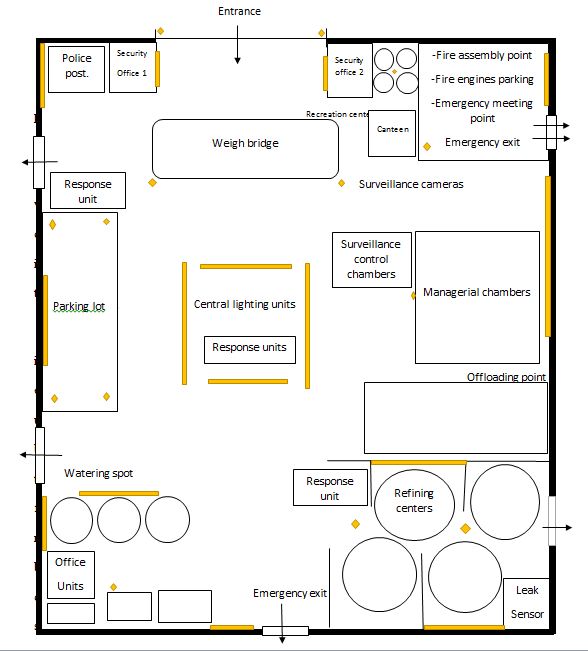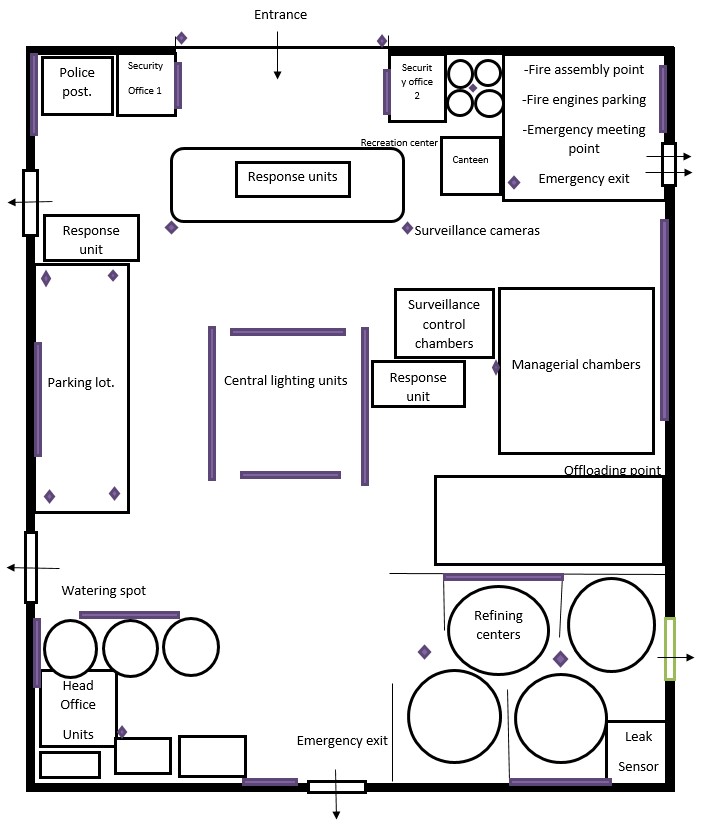The potential threat of operation of an oil refinery
An oil refinery faces threats to its operation on a daily operational basis. Some of these threats can cripple its operations for some hours while other forms of threats can prove to be of potential harm to the refinery. In normal operations of refineries on a global platform is that they deal with extremely flammable crude products. They obtain several sources of energy from the crude oil to be used industrially and in machines that need fuel to be operated with.
There is thus a need for developing an effective Physical Protection system to minimize chances of losses in the event these threats present themselves at any point during the operations. Some of these protection systems will be aimed at protecting the task force behind the operations of the refinery.
One of the potential threats that could be threats to the operation is the fluctuation of the market prices of their oil products. Despite this, however, this is a threat that has its influence from the external environment the refinery cannot control (Fennelly, 2012). The company will thus develop effective measures to ensure sustenance of operations even in the wake of fluctuating fuel prices in the country. Another threat to operation is the development of fire as a result of oil spills in the industry. This is a very big and serious threat that could lead to loss of lives of different people involved in operations (Doyle, 2008). Dealing with flammable substances means the risks of fires during operations.
The identified threats have different targets, for instance fluctuating market prices will affect the production unit and thus the company will run on losses. The threat of fires will target the loose lope holes resulting from oil spills in the refinery units. A mechanism has to be developed to alert the relevant workers in the event of an oil leak.
Design of a physical security chart


Effectiveness of the proposed protection system
The representation of the proposed physical protection system for the oil refinery is presented above. The first step of the protection system is to identify the main objectives of the protection system. In our case, the main objective is to minimize chances of fires resulting from oil spills and to minimize theft of resources from the process of refinery.
In order to come up with the objectives, there must be a clear understanding of the refinery’s operations, and the conditions necessary for effective operations to be sustained (Fennelly, 2012). The second step is to identify the possible threats to be addressed by the protection system and lastly identify the targets the threats pose to the refinery.
The characterization of the refinery operations and the environments involves the identification and description of the refinery. This includes the physical location, the number of employees on the premises, the building plans and the access points to the refinery chambers.to understand the effectiveness of the proposed protection system, the company needs to highlight a brief description of the processes that take place in the refining plant and give a highlight of the existing protection system (Sivarajasingam, 1999).
This point will highlight the reasons for failure of the plan and the reason the company seeks to implement a new protection plan in the refining center. The required information can be obtained from different sources for instance the buildings blueprint for the building layouts and the access points in the company refining chambers, the processes described in the form of regulations of operating the refinery operations, safety description analysis reports by the relevant safety authorities, environmental assessments, and the relevant body in charge of planning for the refining centers.
The protection system should be able to accommodate all the safety requirements in the form of employee security, the lighting in the refining units, the health treatment strategies of the pollutants and the disaster management strategies put in place by the refining plant.
Pros and cons of proposed security plan
The main advantage of the proposed security plan is that it has highlighted the important strategies put in place to curb instances of threats to operations. This will be handled by the response units in the model. The response unit ensures that effective responsive measures have been undertaken in the event of a threat. Another advantage is that, due to the sensors, there tends to be an improved leakage and spillage detection. Through the sensory detectors, the responsible parties will be able to identify areas with oil leakages and correct the conditions before they can cause a fire (Garcia, 2007).
Despite this, however, there is an increased production cost as a disadvantage as the proposed security plan has a high cost of installation. The maintenance costs can be higher than the initial costs but the effectiveness of the systems overweighs the demerits. The different effective units of the security system make operations effective and thus improve performance in the refining plant.
The security plan will secure the company’s operations from the internal environment of theft, fires resulting from oil spills, and poor disaster management strategies resulting from poor planning and building plans. The risk the security plan has is that it cannot protect the firm from external environments and thus making it a threat to operation in the event of an external attack.
An example of these attacks will include the fluctuating prices of oil and their respective refined products. As a strategy to ensure that the system breach, the security plan will be highly encrypted with keys and the encryptions handed to the chief of security in the refinery plant (Siegel, 2007). As an action plan, in the event of a breach, however, the system will be programmed to execute a delay model that will delay all the activities concerning the security model. This will alert the relevant authority in the breach.
References
Doyle, J. E. (2008). Nuclear safeguards, security and nonproliferation: Achieving security with technology and policy. Amsterdam, NY: Butterworth-Heinemann.
Fennelly, L. J. (2012). Handbook of loss prevention and crime prevention (5th ed.). Waltham, MA: Elsevier.
Garcia, M. L. (2001). The design and evaluation of physical protection systems. Boston, MA: Butterworth-Heinemann.
Garcia, M. L. (2007). Design and evaluation of physical protection systems. Oxford, UK: Butterworth-Heinemann.
Siegel, L. J. (2007). Criminology: Theories, patterns, and typologies. Belmont, CA: Thomson/Wadsworth.
Sivarajasingam, V. (1999). Effect of urban closed circuit television on assault injury and violence detection. Injury Prevention, 9(4), 312-316.